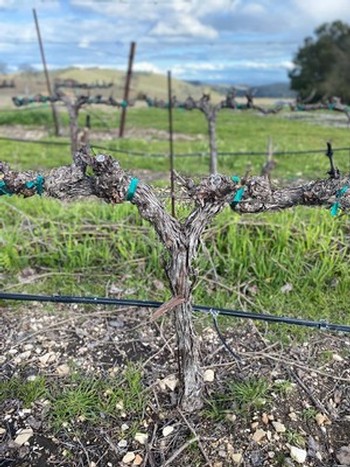 Our wet and cold winter has continued here at Calcareous, and it is a most welcome development for our vineyard. As of March 5th, we have received 26.27 inches of rain this year, well above our annual average of 19 inches. Storms are expected to continue throughout March with the potential to exceed 30 total inches of rain, which would certainly be a record since planting the vineyard in 2002. After a few years of drought, this amount of moisture is most welcome as it recharges ground water, leaches the soils of salt buildup, and gives the dormant vines a healthy start to the 2023 growing season.
Our wet and cold winter has continued here at Calcareous, and it is a most welcome development for our vineyard. As of March 5th, we have received 26.27 inches of rain this year, well above our annual average of 19 inches. Storms are expected to continue throughout March with the potential to exceed 30 total inches of rain, which would certainly be a record since planting the vineyard in 2002. After a few years of drought, this amount of moisture is most welcome as it recharges ground water, leaches the soils of salt buildup, and gives the dormant vines a healthy start to the 2023 growing season.
In addition to the wet weather this winter, we are also benefitting from the fact that it has remained very cold. It takes a combination of warming nights and longer days to wake the vines from dormancy, leading to bud break. The past 2 winters were so dry and sunny, bud break began in mid/late February. However this year, we are now into March and there is still no sign of it. With the vines still in deep slumber when the snow started falling (for only the second time ever recorded at our Estate!) we were able to enjoy beautiful sights and snowball fights. If this had happened during last year’s early bud break, it could have been a disaster. So all things are looking up, with a late bud break hopefully helping to push harvest back to a more typical September start after last year’s early start in August.
Head Winemaker, Jason Joyce
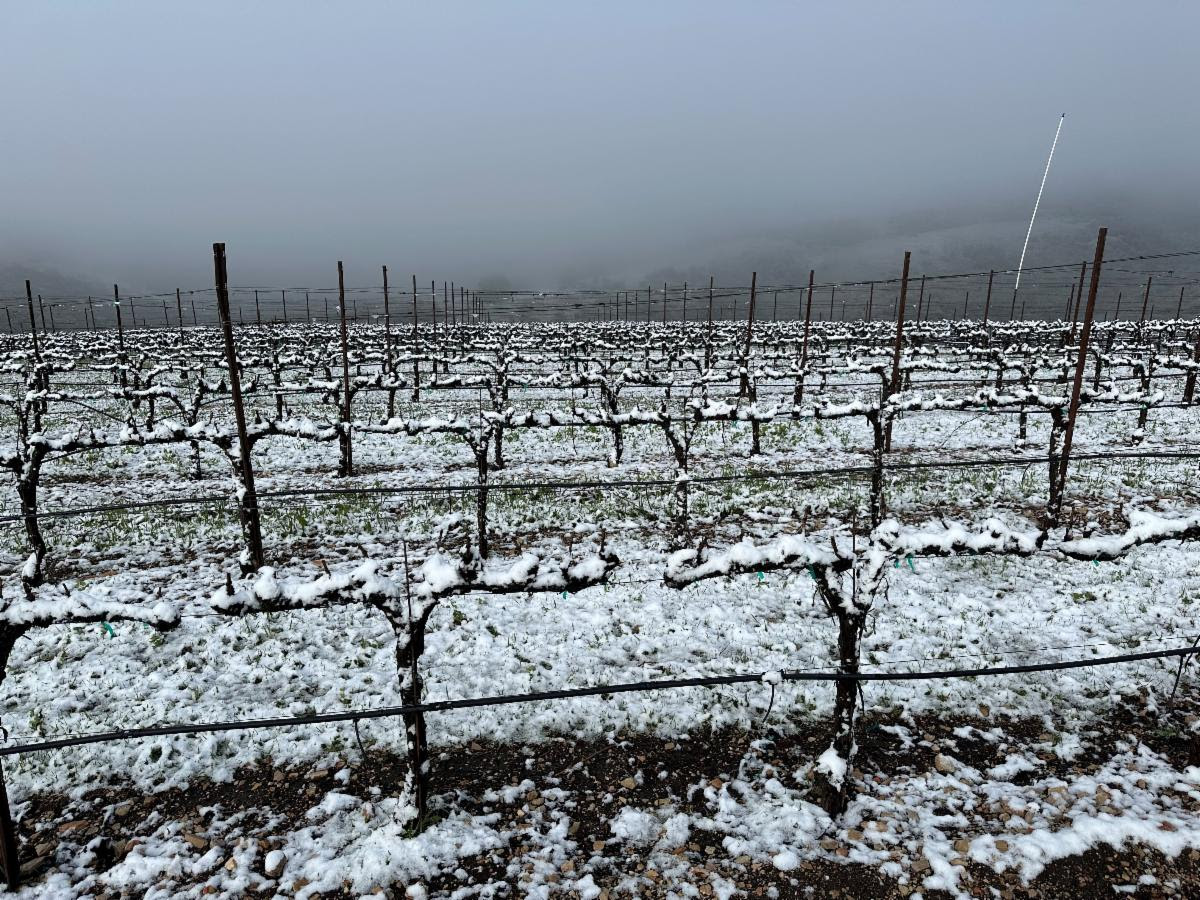
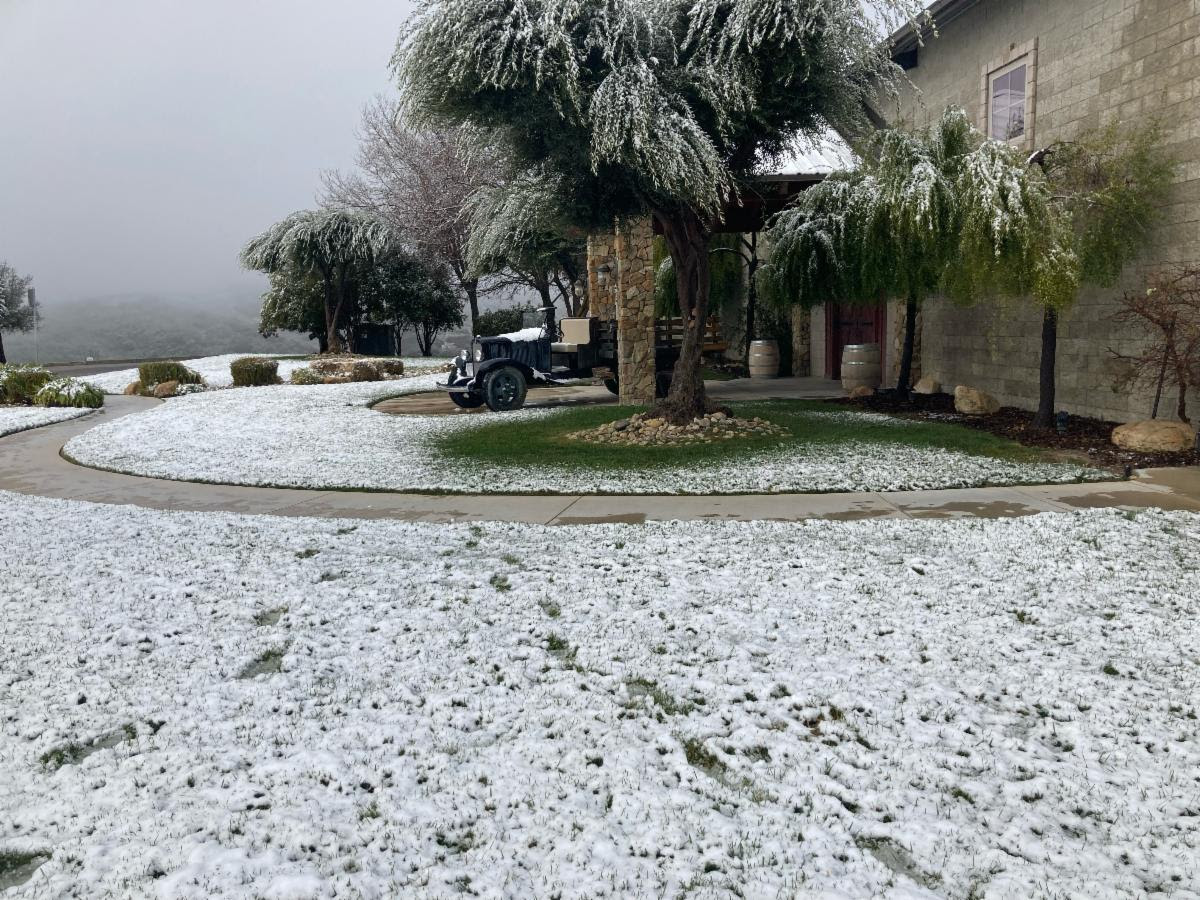
Picking of fruit for 2011 is now done. Last week was a non-stop pick and process fest as a big storm was heading into town and things needed to get off the vine before the wet weather arrived.
Being a winemaker means you are obsesed with weather. This time of year, the weather you are most concerned with is rain. When rain will arrive, and how much will come down will make your picking decisions for you. So trying to predict what is on the way is of utmost importance.
In addition to basic weather reports, and the fancy wine grape based weather report we get from the Paso Robles Wine Country Alliance, there are a couple of other inputs I use. The mostly I use the Pacific Surf Forecast. Whereas farmers are mostly concerned with what is happening right outside, surfers are more concerened with what is happening 1000's of miles away. If you read this stuff often enough, you start to see how weather, for example, off the coast of northern Japan can affect weather here in California. Understading the global trends and patterns of weather can often give you a good idea of what is comming your way well in advance.
Lastly, and most accurate, is this weather device for rain and cold:
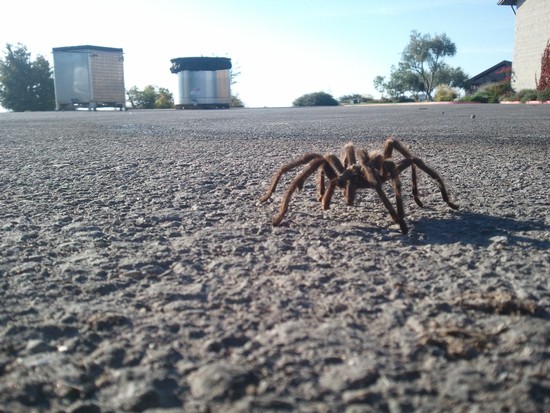
Whenever these dudes start marching around the winery, I know something is up. I don't know if they are heading for high ground to stay dry or warm or what. But once I see a bunch of this kind of action, it's time to talk with the vineyard crew. This was the Saturday before last. I banked on this guy knowing what was up and called for 5 straight days of picking everything we had left on the vine. Worked out as we got done Thursday night and it poured all Friday, Saturday and Sunday. So thanks to my weather guy above for the heads up!
As a winery grows, the most pressing concern on the wine making side is how to expand production without loss of quality. The key reason quality can differ as growth takes place is the choice of new vineyards. In that spirit, it has taken 3 years of patience to find another Chardonnay vineyard here in Paso Robles that we felt comfortable with. The 2011 vintage marks our fist attempt to get to know this place. (People commonly claim that the French word Terroir has no translation to English, I disagree. To me it means place, as in "It's almost as if that building is of this place." Writing this blog has reminded me that the English language can be as beautiful as any if used with consideration.)
The only comparison I can find to this type of nervous excitement is a first date. When all possibilities are still available, your dreams framing what could be.
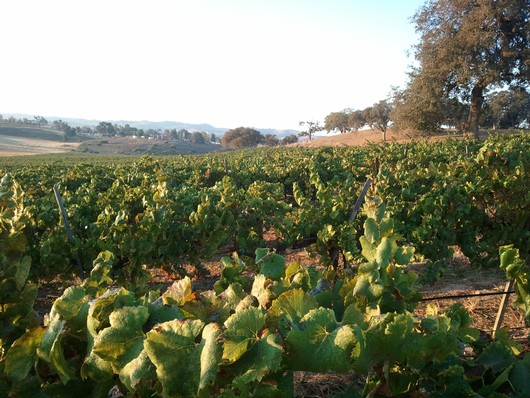
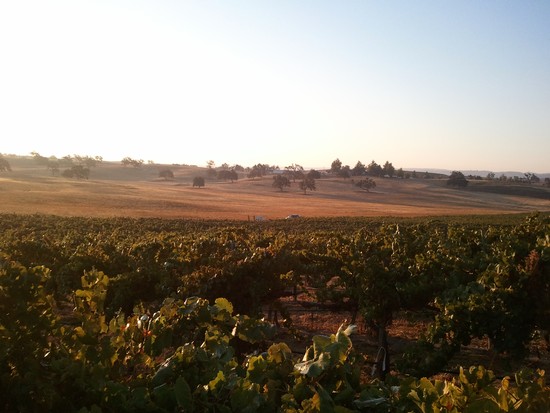
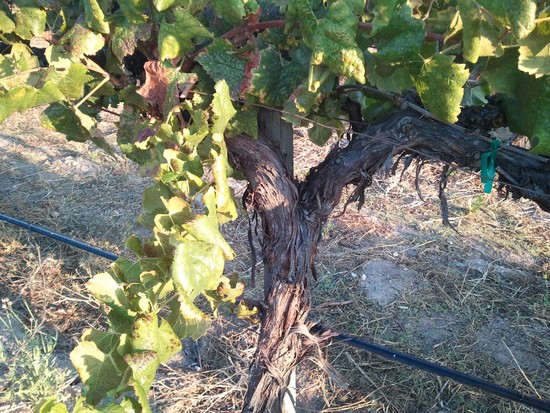
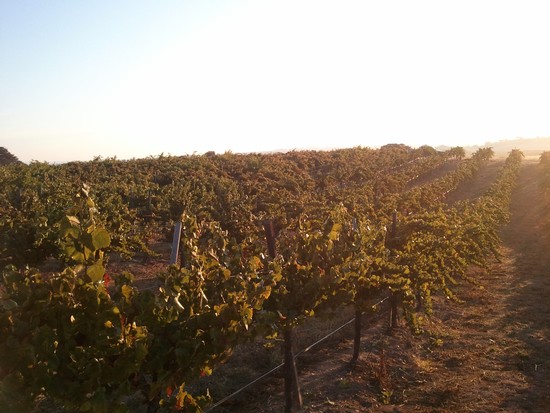

The vineyards this morning produced a most philosophical perspective in me. Sunrise amongst the greenery and expansive views sometimes bring forth thoughts beyond worries of heat stress and micro-nutrient uptake. My thoughts were constantly returning to what is this essence of wine that fascinates? Why don’t people spend weekends traveling the back roads of Forest Grove Oregon and why are fortunes not made and lost based on scores from the Rutabaga Advocate? Is the wine grape a most noble crop that resides in a special world of agriculture above all others? Not that I have seen or experienced. A product lovingly raised is always unique and cherished. How then do we explain the belief that wine is portal through which deeper knowledge comes? Countless Movies, books, and blogs have all been dedicated to idea that wine produces a unique signature of place, the terroir. But does a grape vine speak more to the terroir than an heirloom tomato or pasture raised beef? In this summer season of plenty, with the mantras of slow food and flavors of locality preached on each menu, you would be mad to suggest so. Any random combination of those offerings explains Paso Robles on the palate just as much as a wine can. So again I ask myself, why the captivation with this drink?
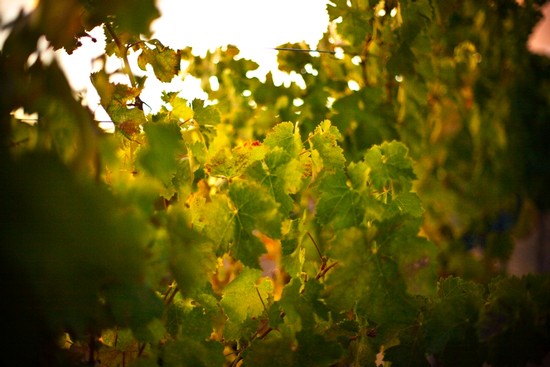
The answer to these type of questions often lie in that time which formed my perspective, my youth. Maybe it’s the answer to the riddle the Jims (Henson and Croce) asked of me in childhood. I remember the strange anxiety that small skit created in me and my initial dawning of thought on the enigmatic complexity of life, time and space. This great mystery of the unflinching progression of things was always with me in quiet times. In order to remain calm, I convinced myself that there must be a path of grace (with apologies to Terrence Malick) that could lead one away from fear and into understanding. Just because something is beyond comprehension does not mean one should recoil from it; the unknowable should be embraced. The wine we produce then is a product of that acceptance. The vintage is, in its essence, the capturing of the moment into some tangible state.
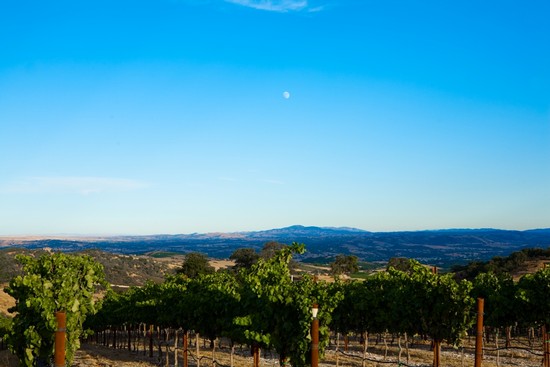
There is something more to wine than mere ethanolic intoxication. The corked bottle represents a chance to return to a place and time, without trepidation that the past is lost forever. Wine with its intrinsic link between our senses and memory can provide a wonderful window unto personal contemplation and revelation.
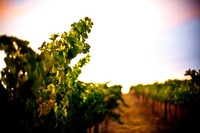
The idea of wine and the memory of my favorite wine experience are forever linked. This occurred on the island of Samos in the Aegean Sea. My future wife and I were enjoying a beach-front campground with a single little market from which to order our dinner. We sat eating a meal of fresh grilled octopus that neither of us would have ordered in different setting. Drinking a local wine, Samos Vin Doux (a fortified muscat!), that we picked off the shelf because it was the only bottle offered. Yet this perfect combination of all things new and beautiful along with the sun resting into the sea, created for us an experience that nothing could ever top. While not by any means the most technically superior wine I have ever had, it is perhaps the best wine I will ever drink.
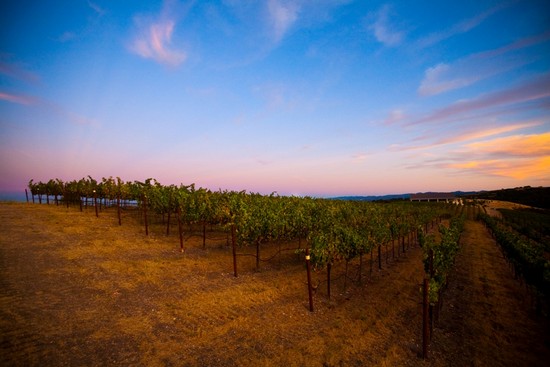
So maybe this isn’t madness, laboring as we do to create wine. As the spectre of harvest looms just weeks away and I prepare to be enveloped completely by its demands, these thoughts give me assurance that it is all worth it. That the sacrifices that must be made of time, energy, mind and family will be rewarded. The goal is sitting out there plain to see in my mind. For me it is the end of November, with fermentations few and a Thanksgiving table filled with family, friends, food, and of course, wine.
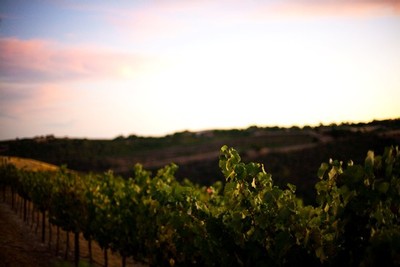
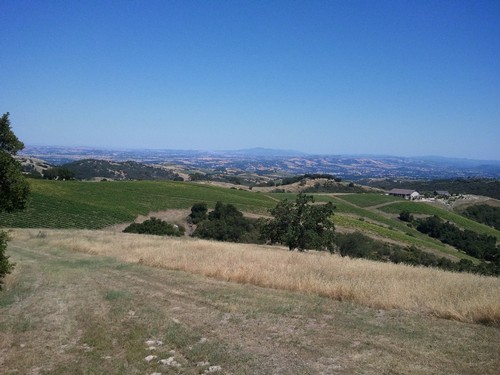
Oh my, summer has finally decided to show up. After all the craziness, like rain the first week of June, it now feels like Paso. After the cool wet winter and spring, the horrendous frosts, all the what nots and who's fors in the vineyard, things are right where they should be. June 21st and the fruit is set on everything but a couple sections of Mourvedre and Cab. The heat that is hitting right now is like flipping the turbo on; the vines seem to be just exploding. It's exciting to see and the daily morning walks in the vineyard have begun.
I firmly believe that the winemaker needs to spend as much time actually in the vineyard as possible. That to me is the whole purpose of having the vineyard and the winery on the same property. So, from this day forth, my assistant winemaker and I (and Abbie and Salty) will spend the first part of every day walking the rows. Seeing the daily changes is the only way to really put oneself on the same time cycle as the plants. Yeah, you can sit in an office and start reading number off of various probes and data collected by others. But that doesn't let you understand the vintage. To feel the dew, fog, sun, soil and wind the same way the plants do. This is where the understanding comes from. This is where the plan comes from. This is where the great wine comes from.
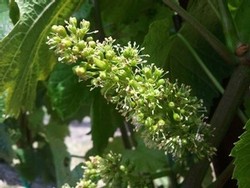
I told you I would get some photos once the grape flower showed itself. Like I said, not anything that Akira Kurosawa would have made into short film. But beautiful none the less to grape farmers and wine makers alike. Crazy to think that it is June 1st, and the Chardonnay is just flowering. Looks like Thanksgiving day for the Cab and Mourvedre in 2011. A long, long harvest awaits. But if it is anything like the long harvest quality of 2010, I'll take it.
The vineyard is safely into vegetative growth mode and it's time for our next crop control measure. This time, all those excess buds that escaped pruning day need to get taken care of. Although the pruned vine looks all clean trim, a couple weeks of shoot growth tells a different story.
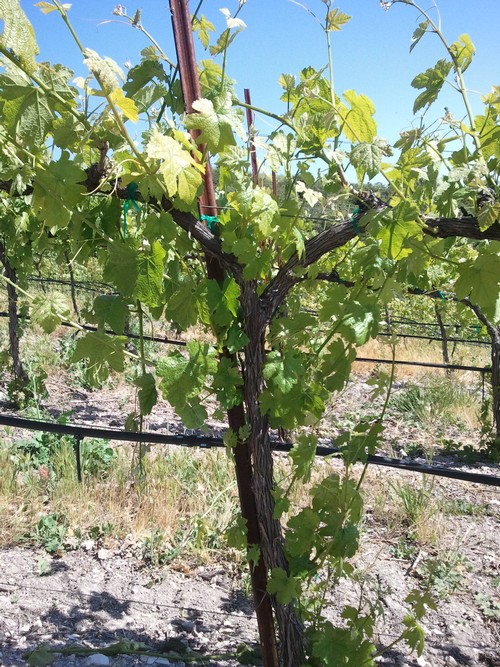
And the whole vineyard looks like that. Luckily when the shoots are young and fragile, they are easy to just knock off. So a haircut is quick and painless and you are left with a beautiful little Syrah vine all ready to start making grapes.
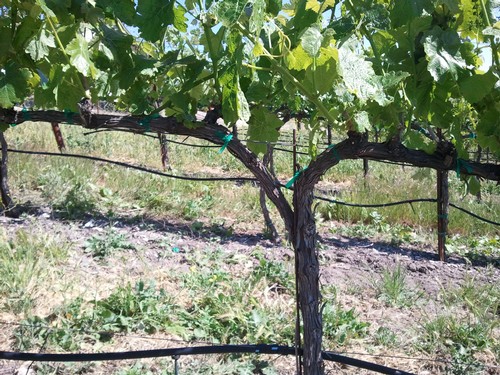
One interesting thing you notice this time of year is the proof you are dealing with a clone grafted onto a root stock and not just a wild vine. The root stock puts out shoots as well. You will see these shoots coming up from the ground that are a completely different species than the Syrah you are hoping to harvest. First, here is a nice close up of a shoot that grew from the cordon, in this case Estrella Clone Syrah.
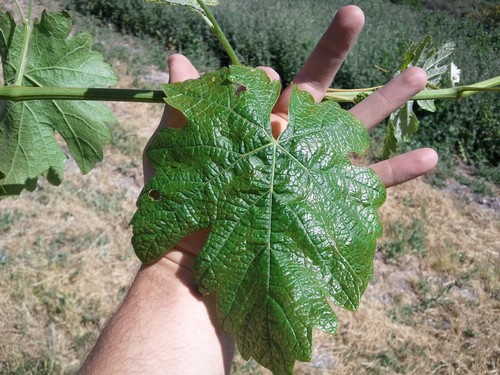
Classic Syrah leaf there, about the size of a typical human paw. Now take a look at what comes creeping out of the 1103 Paulsen rootstock.

For one, the leaf is totally different in shape. But to me, the most drastic difference is the red color of the shoot itself. The first time I walked through a vineyard, I had no idea about the whole rootstock and scion thing going on. So I was a bit shocked at this red chard looking thing bursting out of the vine. This time of year always reminds me of that first vineyard experience, and I hope to never lose that excitement about discovering new things about wine.
As a final little treat, here is the first look at the 2011 crop. Yes, the Syrah inflorescence.
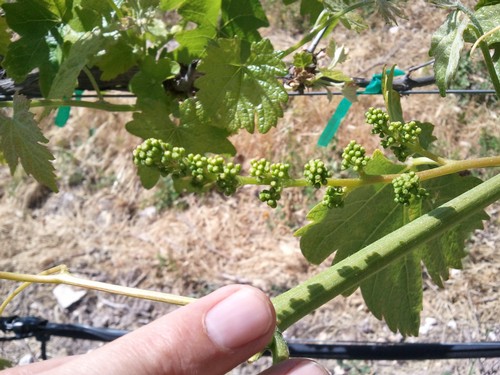
In a week or two, these little guys will pop open and reveal the beautiful grape flower. Once pollinated, these become the grapes. Sure, it's no peach orchard or anything, but it's what the grape farmer gets, and we like it. I'll take a picture of it when it happens, and we can all enjoy the splendor of flowering.
In the fall, the leaves on the vines turn their beautiful colors and eventually fall off. The vines themselves enter a dormant state, mirroring the farmers and vintners who need a long winter's nap to recover from harvest.
Eventually spring rears its wonderful head bringing warmth and sunshine to wake everything up again. The buds on the pruned vines begin to break open and the great cycle of the vintage begins. This week at the end of March marks that beginning for the 2011 vintage.
Now either in tasting notes you have read, or at some winemaker's speech you have survived, you may have heard that not all grapes ripen at the same time. Here at Calcareous, some grapes we pick at the end of August and some we pick in the middle of November. And contrary to what some might say, that waiting until November is not some ploy to get the fruit "over ripe" to make big jammy Paso wine. No, the fact is, each variety planted here marches to its own beat when determining the timing of when its fruit will be ready. Some vines take their own sweet time, and no other time of year shows this as clearly as bud break.
Every year, the first grape picked off the Calcareous vineyard is the Chardonnay. Here is what that Chardy looks like today.

Hope and life spring eternal, literally! An exclamation because you don't get to be literal all that much in life these days. Now of course, the constant worry of a freeze that could damage these fragile buds is ever present. Well, not actually. Here is a tip to any of you out there that are looking to plant a vineyard for your future award winning estate winery. Plant on a steep hill. Oh sure, it makes working the vineyard feel like a constant mountain hike, you need crawler tractors, and irrigation and ripening are irregular. But the big plus, we have never had a frost problem here*. So these buds will soon be leaves, stems, and flowers.
Now, why don't we walk 75 yards due east and see what is happening with the Mourvedre.
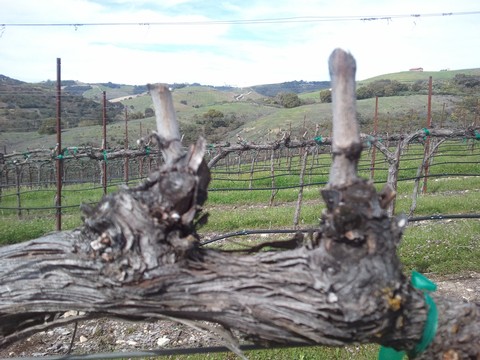
Um, not much. Mourvedre is always in a race with the Lloyd Block Cab Sauv to see who gets picked last. And as you can see here, budding is still a couple weeks away. Not a hint of green anywhere in the whole block. The Mourvedre vines are weeks behind the Chardonnay in general life cycle. Thus, the fruit will ripen weeks later. Sure this is a bit of a simplification of things, but it is always interesting to me see the order of bud break as it outlines my general planning of harvest.
You can start to put together a flow chart in your mind of what fruit will go into what fermenters. There are dreams about various co-ferments from fruit that ripens at the same time. Last year, the top of a section of Syrah and the bottom of the Merlot broke the same week. So I thought, why not, during harvest a small 1 ton co-ferment of the two. If you ever visit in the next year, you can taste that experiment and see what you think. I for one am in love as these two maligned beauties work wonders together. Things like that won't happen every year, so by paying attention to the vineyard now, you can prepare for the little bits of magic as they may occur.
Finally, an aside for those who read my post on pruning. I mentioned that the ideal goal is to get two buds from each spur position. This way you get the low yields and concentrated fruit you hope for. I also mentioned that this two bud thing is a dream. Sometimes, like in the above Chardonnay photo, you get a perfect two buds and all is well. Sadly, a lot of the time things look like this Malbec here.
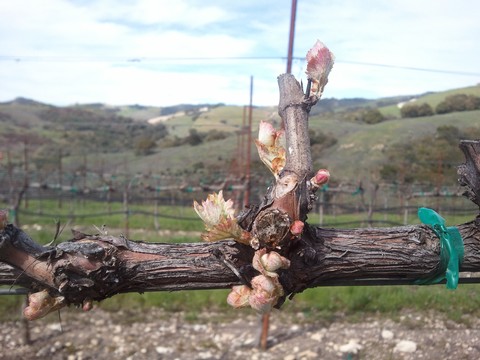
A solid 8 buds there, and that is only the one side. This means that we will have to go back through in the next month, and pull off all the extra shoots. So for those keeping count, this will be the second time this year each vine will be visited and adjusted by hand. There will be many more of these visits over the next 6-7 months. Hopefully I'll write a little post about each of them.
*Please Snow Miser, I am not challenging you. Please stay down in your cold, yet comfortable low lying areas.
After 10 days of rumors and building excitement, it actually happened. Honest to goodness snowfall here at Calcareous. This happens maybe every 2-3 years, we get a bit of a dusting. But this one was a bit more exciting. Actual winter like conditions descended upon the vineyard this past Saturday. The temperature was 31, dropping all the way down to 25 overnight. That is some serious stuff for Central Coast California. We like our February's in the mid 60's and sunny.
But as you can see, everyone was quite excited to see some snow on the ground.
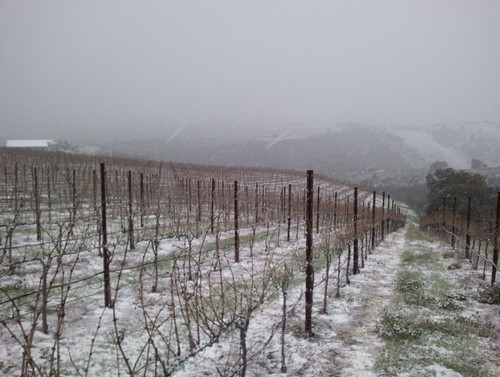
The vines are still dormant, so the cold temps were worry free for any budding that could take place. I was excited about the snow as a test of a little theory of mine. One about vines that, like people, those with more intense life experiences produce much interesting fruit of their labor. (Maybe I've been hanging out with the vines a bit too much as the anthropomorphisms are getting a bit too common.) Anyway, in my world this Cab Sauv vine is going to write a postcard to a cousin in France with the quick note "It's not all sunshine, beaches and easy living here in California!"
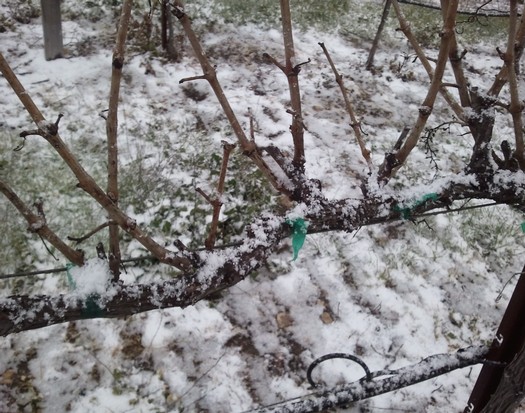
And like any excited snow novice who does not have to worry about shoveling the driveway, or getting to work on icy cold mornings, we made a nice little snowman/deer thing on our picnic table.

The only people that were not overjoyed were the possible picnic basket types who made their way up to our grounds to enjoy the view. Not too cozy out there for the wine and cheese snacking.

The tasting room though was warm and filled with customers hopeful that perhaps they would get snowed in and be forced to stay warm by drinking Cabernet and Syrah all night. Luckily for us all, this did not come to pass.
This time of year, things are a bit slow and predictable in the cellar. The usual week consists of a blending trial here or there in preparation for the spring bottlings. Some topping and checking of SO2 levels is sure to follow. It’s a good time to do barrel evaluations in preparation for the onslaught of barrel salesmen coming in March. And finally, keep tracking malolactic fermentation of the 2010 wines. So, not much too really talk about in a picture page format as far as cellar activities. If you doubt me, well, here is the chromatography.
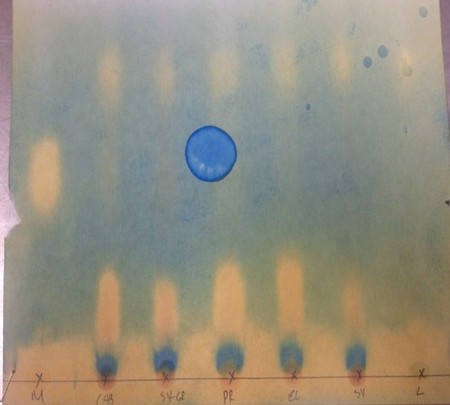
Never mind the big drop of DAP there in the middle, I got a bit too excited. Looks like the Estate Grenache, Block 6 Syrah, and maybe the Glen Rose Syrah are ready to go. Yeah, that’s the stuff of award winning blogging eh?
So instead, I’d like to talk a little about something else happening right now that has a massive impact on wine quality for 2011. We started pruning the vines last week. The way a vine is pruned is the first step you take in influencing the fruit of the next vintage. Pruning basically outlines how much fruit we want each vine to produce, while also limiting the amount of energy used in vegetative growth. Here is what the now dormant vines look like; this is Malbec in case you were wondering.
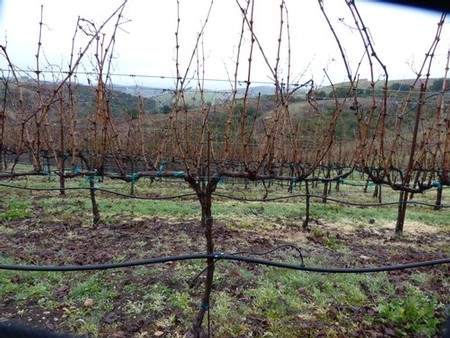
(These vines were planted in 2002! Things grow slowly on limestone.)
Ah, the blank canvas for the pruning shears. It’s time to get to work creating a grape producing masterpiece. Once we are finished, it should look something like this.
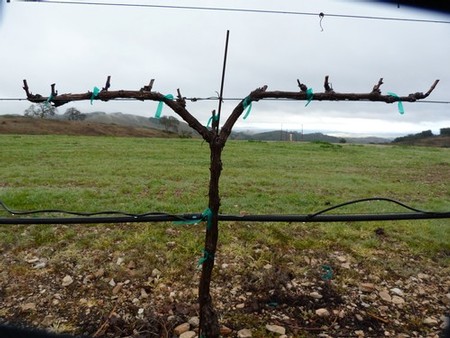
Well, sure, it looks like we hacked away at the thing to leave a vine with a bunch of little stubs. But there is quite a bit of thinking that goes into this. The first time I had to prune I was worthless. I stared, measured, counted my fingers, talked to the vine, everything to make the perfect prune. I was slow to the point of just being in the way. And to top it off, even with all my science and thinking, I was still making bad decisions. After a couple of hours though, the Zen of pruning begins to set in. The points where it is best to clip start to organically appear to you. I’m still no Edward Scissorhands like our vineyard manager Martin, but I can hold my own now.
For the home ranch, we use a cordon training system. The central vertical trunk splits into two permanent horizontal parts. This horizontal part is called the cordon. On the above photo, there are 5 nubs on each side of the cordon. Those nubs are the permanent spur positions, the locations where we will allow the yearly vegetative shoot growth.
Here is a close up shot of a spur position before pruning.
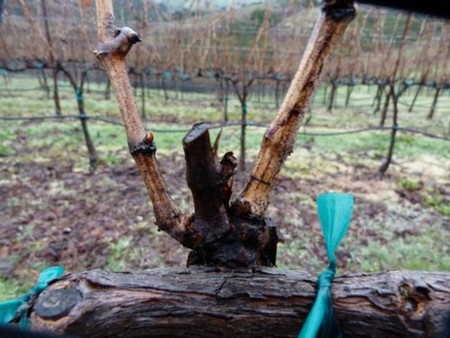
As you can see, two shoots grew from the spur position. This is our first and foremost form of growth control. We want to limit things to 10 Spur positions per vine, thus 20 shoots per vine. And since each shoot will typically only produce two clusters per shoot, we would have 40 clusters per vine in a perfect world. You never get that much fruit, but if left untended until harvest, that would be your max. It makes the fruit dropping that takes place at veraison much easier when pruned like this.
So how do you get the nice perfect two shoots of growth from each spur, well here is a handy photo to demonstrate.
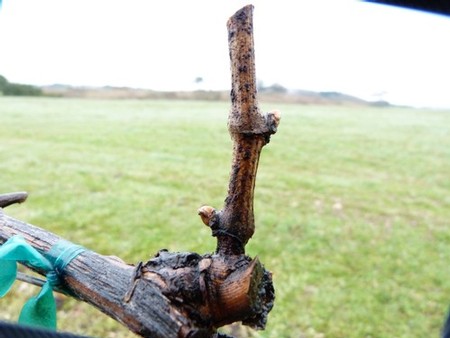
This is not an ideal spur here. The buds, the two white bumps, are too far from the cordon for my liking. But this photo nicely demonstrates the two buds per spur position pruning goal. Ideally, your buds will be really close to the cordon so that each year, the spur becomes a nice tight knot on the cordon. If you see a vine with spurs that are growing way away from the cordon, you got some lazy pruners, possible poor growth, and some angry grape pickers during harvest.
Here is what happens when you let your wine maker learn pruning the previous year.
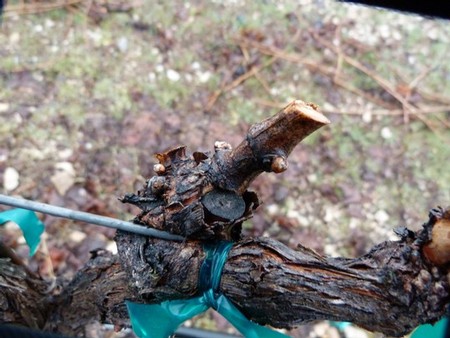
An ugly mess with buds all over the place. Now we will have to come back after bud break and knock off all the excess shoot growth. I let Martin handle this one this year, and he already did a great job of getting it under control. After pruning next year, that spur position will be beautiful.
In my humble opinion it can not be overstated how important vineyard practices like pruning are in determining the final product, the wine. With each cut, we are impacting how the vine will grow, how it will produce fruit, and how healthy it will be. It is a common throw away line in wine maker bios about how “the best wine is made in the vineyard”. This is what is meant by that. Pruning is a back breaking, hand killing endeavor that needs to be carried out as carefully as any sorting, punch down or pressing that happens during harvest. When done correctly with proper care, the foundation for great wine is laid.